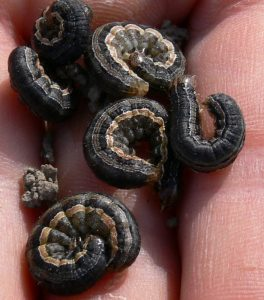Larvae could still damage spring cereals and mixed forages
By Kaitlynn Anderson
Staff Writer
Farms.com
A tough pest is crawling across some Ontario fields.
Some producers recently discovered low concentrations of armyworm in their winter wheat, Tracey Baute, field crop entomologist with OMAFRA, said in an article yesterday.
Farmers may not be concerned about these fields, as they will soon harvest the crops. However, they should watch for the pest in their spring cereals and mixed forages, Baute said.
Growers may want to scout their fields shortly after dusk, which is when larvae actively feed on the plants. In 10 different locations in their fields, farmers should count how many larvae appear per square foot.

Tracey Baute photo
If producers find an average of five or more larvae per section in their mixed forages, they may want to take action. In seedling crops, this threshold drops to two to three larvae, Baute said.
For cereal crops, growers may want to use pesticides if they find an average of four or five larvae per square foot. However, producers should first ensure that the pests do not have white eggs on their backs. These eggs indicate that parasites have infected the insects.
“Avoid treating (fields) with insecticides when large numbers of parasitized larvae are present, as they have already been controlled by parasitoids,” Baute said.
In all cases, farmers should only act if the pests are less than 2.5 cm (one inch) long. Once the larvae become larger than this length, they often stop feeding on the crops, Baute explained.
For more information on armyworm management, check out the Farms.com Field Guide.
Farms.com has reached out to an agronomic specialist for further comment.
Tianika/iStock/Getty Images Plus